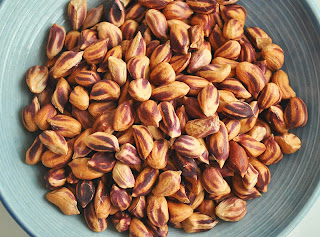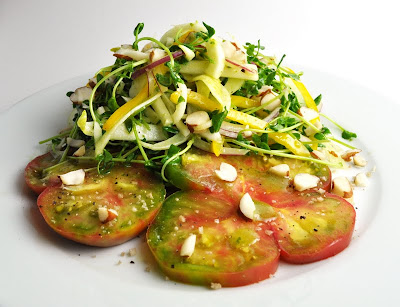A few nights ago, my son came into the kitchen in search of a quick something for dinner. At the time, I was assembling that "Taboulesque" salad I mentioned a few days ago, and my wife was sautéeing some freshly harvested zucchini and yellow squash.
The idea of pasta with tomato sauce was floated, to a slightly better than tepid response, but as it turned out, we had no tomatoes (believe it or not). We had already put the water on to boil the pasta (brown rice pasta, that is), so I had to think fast. We had no pesto either, but I did happen to have about a cup of sundried tomatoes (the dry, unmarinated kind). I threw them into the blender and added some hot water, a vegetable bouillon cube, garlic, salt, a little EVOO, and a couple sprigs of fresh oregano. I whipped it all to a smooth consistency, and that was it; three minutes flat. All that remained was to heat the sauce in a pan and grind in some black pepper.
When the pasta was firmer than my wife likes it, and not as firm as I like it (that's marriage for you), I drained it, keeping just a dribble of the cooking water, and sloshed it around in the sauce.
Marcella Hazan has famously--and snobbishly, frankly, although truthfully--accused Americans of using too much sauce on their pasta. I believe she would have approved of our starch-to-flavor ratio on this one occasion.
I don't eat pasta often (even the brown rice variety), so maybe the novelty of it influenced my enthusiastic response, but I think it's safe to say that everyone was glad we made a lot of this dish. I had no intention of photographing, or even mentioning this sudden addition to the meal, but after the first couple of bites, I whisked my plate away and fired off a few shots. As you can see, we had it on the same plate (infamia!) with my wife's delicious sautéed squashes. Heavenly.
A quick note about brown rice pasta, for those who may not have heard me rant about it: I've tried several substitutes for the real thing--the refined wheat pasta that is universally adored, but now widely shunned for one (good) reason or another. Whole wheat pasta is a wholesale loser (don't even try it). Quinoa pasta is a marginal contender, but it stops short of convincing me, and of course it does fall apart. Brown rice pasta has virtually identical properties to the world's favorite (or perhaps, as I said, it's been long enough since I've had the real thing, I don't mind the minor inconsistencies). At any rate, this is an excellent stand-in, and I'm not easy to impress, so there. We used fusilli, which are among the lest forgiving shapes, and they held together flawlessly.
Proud owners of Speed Vegan will most likely know about this sauce, because it's basically a form of "Sundried Tomato Paste" from the "Jump Starts" section of the book, with a little vegetable broth added. The recipe in the book goes something like this:
.
The idea of pasta with tomato sauce was floated, to a slightly better than tepid response, but as it turned out, we had no tomatoes (believe it or not). We had already put the water on to boil the pasta (brown rice pasta, that is), so I had to think fast. We had no pesto either, but I did happen to have about a cup of sundried tomatoes (the dry, unmarinated kind). I threw them into the blender and added some hot water, a vegetable bouillon cube, garlic, salt, a little EVOO, and a couple sprigs of fresh oregano. I whipped it all to a smooth consistency, and that was it; three minutes flat. All that remained was to heat the sauce in a pan and grind in some black pepper.
When the pasta was firmer than my wife likes it, and not as firm as I like it (that's marriage for you), I drained it, keeping just a dribble of the cooking water, and sloshed it around in the sauce.
Marcella Hazan has famously--and snobbishly, frankly, although truthfully--accused Americans of using too much sauce on their pasta. I believe she would have approved of our starch-to-flavor ratio on this one occasion.
I don't eat pasta often (even the brown rice variety), so maybe the novelty of it influenced my enthusiastic response, but I think it's safe to say that everyone was glad we made a lot of this dish. I had no intention of photographing, or even mentioning this sudden addition to the meal, but after the first couple of bites, I whisked my plate away and fired off a few shots. As you can see, we had it on the same plate (infamia!) with my wife's delicious sautéed squashes. Heavenly.
A quick note about brown rice pasta, for those who may not have heard me rant about it: I've tried several substitutes for the real thing--the refined wheat pasta that is universally adored, but now widely shunned for one (good) reason or another. Whole wheat pasta is a wholesale loser (don't even try it). Quinoa pasta is a marginal contender, but it stops short of convincing me, and of course it does fall apart. Brown rice pasta has virtually identical properties to the world's favorite (or perhaps, as I said, it's been long enough since I've had the real thing, I don't mind the minor inconsistencies). At any rate, this is an excellent stand-in, and I'm not easy to impress, so there. We used fusilli, which are among the lest forgiving shapes, and they held together flawlessly.
Proud owners of Speed Vegan will most likely know about this sauce, because it's basically a form of "Sundried Tomato Paste" from the "Jump Starts" section of the book, with a little vegetable broth added. The recipe in the book goes something like this:
Sundried Tomato Paste
Makes about 1 1/4 cups
A terrific thing to have around for a number of uses, you can add this to sauces, soups, and dips for added flavor and complexity. Use it as a sandwich spread. Add a little hot broth for a quick, light pasta sauce.
1 jar (4.5 ounces drained weight) marinated sundried tomatoes, thoroughly drained
2 teaspoons minced garlic (or pressed)
1/2 teaspoon salt
1/4 teaspoon freshly ground black pepper
2 tablespoons extra virgin olive oil
1/2 to 3/4 cup water, as needed
Combine all the ingredients in a blender and puree thoroughly.
.


















